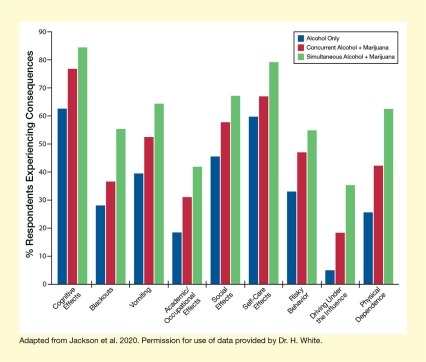These studies found that:

- College students who used marijuana and alcohol simultaneously experienced more negative consequences than those who used both substances sequentially.
- College students who used both substances sequentially reported more negative consequences than those who only used alcohol.
- Young adults drank more alcohol on days when they also used marijuana than on days when they only drank alcohol.
- Young adults reported more harms on days when they used both substances than on days when they used only one or the other.
With more widespread legalization of marijuana for medicinal and recreational purposes, its use has increased, especially among young adults. Given the pervasive alcohol use in this age group, it is important to investigate the consequences of using both substances together. Three recent studies investigating this issue indicate that simultaneous alcohol and marijuana use (SAM) is associated with both increased alcohol consumption and greater negative consequences.
SAM Leads to More Negative Consequences in College Students
Dr. Kristina M. Jackson and colleagues from the Center for Alcohol and Addiction Studies at Brown University and Dr. Helene R. White from the Center on Alcohol Studies at Rutgers University compared negative consequences experienced by college students who engage in SAM to those experienced by students who used both substances but not at the same time (concurrent alcohol and marijuana use [CAM]), and those who used only alcohol. The researchers analyzed online surveys of 1,390 full-time college students ages 18 to 24 who had used alcohol and marijuana in the past year. The students were recruited from colleges in three states with different state laws regarding recreational marijuana use.
The team first compared how many negative consequences people who engage in SAM, those who engage in CAM, and those who only use alcohol reported experiencing; the survey included nine different consequences:
- Cognitive, academic, social, and self-care effects
- Blackouts
- Vomiting
- Risky behavior
- Driving under the influence
- Physical dependence
In contrast to earlier studies, the researchers controlled for factors that could be higher among people who engage in SAM and could increase risk of experiencing negative consequences, such as greater/more frequent alcohol and marijuana use, certain socio-demographic characteristics (e.g., sex and race/ethnicity), and certain psychosocial characteristics (e.g., impulsive behavior). Even after controlling for these factors, people who engaged in SAM reported significantly more negative consequences than those who engaged in CAM, and the SAM and CAM groups experienced more negative consequences than those who only used alcohol. Additionally, the SAM group was most likely, and the alcohol-only group was least likely, to report each type of negative consequence, although the differences were not always statistically significant (see Figure).
The researchers also found that people who engaged in SAM were more likely to attribute the negative consequences they experienced to their alcohol use than to the simultaneous use of both substances. “Whether this attribution was due to ‘myths’ about marijuana use being benign or to heightened prevention messages about harms associated with alcohol use needs to be further investigated,” says Dr. Jackson. One exception was that more individuals in the SAM group reported driving under the influence of marijuana than under the influence of alcohol alone or combined with marijuana. Dr. White speculates that, “Perhaps this generation, which has been socialized not to drink and drive, is unlikely to drive under the influence of alcohol, or to report doing so.”
Overall, the results indicate that college students need to be better informed about the potential harms associated with marijuana use and especially with SAM, including driving under the influence. Therefore, prevention programs targeted at multiple substances, including simultaneous substance use, should be implemented on college campuses.
SAM Increases Alcohol Consumption and Consequences in Young Adults
One limitation of the study by Dr. Jackson and colleagues was that it included only college students, whose behavior may not be representative of all young adults. However, their findings are supported by a study by Dr. Christine M. Lee and colleagues from the University of Washington School of Medicine and Dr. Megan E. Patrick from the University of Minnesota, who assessed alcohol consumption and alcohol-related consequences in a community sample of nearly 400 young adults who used alcohol and marijuana simultaneously.
The participants completed online surveys twice a day for two 14-day periods approximately 4 months apart. On SAM days, the respondents consumed greater amounts of alcohol and reported more alcohol-related consequences (both negative and perceived positive consequences) compared with days when they only drank alcohol. The increase in negative alcohol-related consequences (e.g., hangover, nausea, and vomiting) was partially explained by the greater alcohol consumption on SAM days. The increase in perceived positive consequences (e.g., feeling more relaxed or in a better mood), however, was significant even after accounting for amount of alcohol consumed.
Findings by Dr. Ashley N. Linden-Carmichael and colleagues from Pennsylvania State University further support the hypothesis that SAM has different consequences than separate use of both substances. These investigators wanted to go beyond comparing SAM users versus people who use just one substance or the other by studying young adults who use both, but not always at the same time. For each participant, the team compared consequences on days with SAM, alcohol-only use, and marijuana-only use. Explains Dr. Linden-Carmichael, “This approach allows for a better understanding of whether harms associated with combining alcohol and marijuana are simply due to differences between people, or whether it is actually their substance use behaviors that are linked with harms.” The participants completed up to 14 daily assessments of their substance use.
The young adults reported more negative consequences, such as experiencing negative physical side effects, forgetting what happened the night before, or embarrassing themselves, on SAM days than on days when they used only alcohol. Similarly, they reported more negative and perceived positive consequences on SAM days than on marijuana-only days. “Importantly, we found that young adults experience more harms even after adjusting for the amount of alcohol and/or marijuana they were using and whether they were using other substances such as nicotine products or other drugs,” says Dr. Linden-Carmichael.
According to Dr. Linden-Carmichael, the findings have important implications. “In developing highly effective substance use interventions, we should consider the role of all substances young adults may be using and whether they are using substances at the same time with overlapping effects,” she says.
The work of Dr. Jackson and colleagues was supported by NIDA grants DA040880 and DA016184; the work of Dr. Linden-Carmichael and colleagues was supported by NIDA grants DA039838 and DA017629.
- Text Description of Figure
The bar chart illustrates the percentage of college students who engaged in alcohol use only, CAM, or SAM and experienced any of nine different consequences. Blue bars represent respondents who used alcohol only, red bars represent respondents who engaged in CAM, and green bars represent respondents who engaged in SAM. The horizontal x-axis shows the different consequences of substance use assessed. The vertical y-axis shows the percentage of respondents who experienced the respective consequences on a scale from 0 to 90 percent. Cognitive effects (first set of bars) were reported by about 63 percent of respondents who used alcohol only, about 77 percent of those who engaged in CAM, and about 85 percent of those who engaged in SAM. Blackouts (second set of bars) were experienced by about 28 percent of respondents who used alcohol only, about 37 percent of those who engaged in CAM, and about 56 percent of those who engaged in SAM. Vomiting (third set of bars) was reported by about 40 percent of respondents who used alcohol only, about 53 percent of those who engaged in CAM, and about 65 percent of those who engaged in SAM. Academic or occupational effects (fourth set of bars) were endorsed by about 19 percent of respondents who used alcohol only, about 31 percent of those who engaged in CAM, and about 42 percent of those who engaged in SAM. Social effects (fifth set of bars) were endorsed by about 46 percent of respondents who used alcohol only, about 58 percent of those who engaged in CAM, and about 68 percent of those who engaged in SAM. Self-care effects (sixth set of bars) were reported by about 60 percent of respondents who used alcohol only, about 68 percent of those who engaged in CAM, and about 80 percent of those who engaged in SAM. Risky behavior (seventh set of bars) was reported by about 33 percent of respondents who used alcohol only, about 47 percent of those who engaged in CAM, and about 55 percent of those who engaged in SAM. Driving under the influence (eighth set of bars) was endorsed by about 5 percent of respondents who used alcohol only, about 19 percent of those who engaged in CAM, and about 36 percent of those who engaged in SAM. Physical dependence (nineth set of bars) was experienced by about 26 percent of respondents who used alcohol only, about 43 percent of those who engaged in CAM, and about 635 percent of those who engaged in SAM.
Sources:
- Jackson, K.M., Sokolovsky, A.W., Gunn, R.L., and White, H.R. Consequences of alcohol and marijuana use among college students: Prevalence rates and attributions to substance-specific versus simultaneous use. Psychol Addict Behav 34(2):370‐381, 2020.
- Lee, C.M., Patrick, M.E., Fleming, C.B., et al. A daily study comparing alcohol-related positive and negative consequences for days with only alcohol use versus days with simultaneous alcohol and marijuana use in a community sample of young adults. Alcohol Clin Exp Res 44(3):689-696, 2020.
- Linden-Carmichael, A.N., Van Doren, N., Masters, L.D., Lanza, S.T. Simultaneous alcohol and marijuana use in daily life: Implications for level of use, subjective intoxication, and positive and negative consequences. Psychol Addict Behav 34(3):447‐453, 2020.
